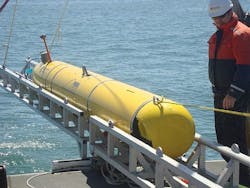Officials of the Naval Research Laboratory (NRL) at Stennis Space Center, Miss., announced a $7.1 million contract to Bluefin on Friday for the Black Pearl AUV (autonomous underwater vehicle) system. The actual date of contract award was 22 Jan. 2014.
The NRL's Black Pearl program is developing an underwater drone for research in long range and multi-static mine hunting and ASW programs, as well as in new distributed sensing research. For this project Bluefin experts will develop as many as five next-generation underwater drones based on the company's Bluefin 21 UUV.
Navy researchers are awarding the contract to Bluefin sole-source because the mechanical, electrical, and logical interfaces are specific to the Bluefin 21. The control software between the payloads and the main vehicle computer that controls the overall mission, also is unique.
NRL scientists have designed and built significant hardware and software over several years that works effectively with the Bluefin 21 architecture, officials say, explaining that no other UUV is appropriate for this kind of research.
The Navy's Black Pearl UUV research program calls for Bluefin to develop a state-of-the-art 21-inch-diameter UUV with GPS/INS/DVL navigation capability, low noise propulsion, and onboard energy sufficient to carry out missions longer than 24 hours. The vehicle will carry out missions according to a sortie plan defined by an operator employing a graphics-based PC mission planning tool.
The top-level requirements for the vehicle are a 3-to-5-nautical-mile per hour operating speed, a 400 meter depth capability, a minimum of 18 kilowatt-hour energy storage, and a real-time GPS-aided fiber optic gyro (IXSEA PHINS III), inertial navigation system (INS) integrated with Doppler velocity log instrument capable of measuring the vehicle's horizontal position, velocity, and attitude.
Related: Hydroid asked to repair and upgrade Navy's fleet of MK 18 unmanned underwater vehicles
The position accuracy drift rate while traveling submerged on a straight line, will be 0.15 percent of distance traveled, or less. The system should have an over-the-horizon (OTH) communication capability for periodic vehicle status, monitoring, and redirection using Iridium satellite communications system while the vehicle is on the surface.
The UUV should be able to support several payload types, supplied by NRL researchers, that may include broadband low frequency sonars for MCM and ASW; environmental data sensors such as water depth, speed of sound in water along vehicle path, water temperature, and water current); and payloads for acoustic modem research (ACOMMS).
The Bluefin 21 can carry several sensors and payloads at once in swappable payload sections and battery modules for in-field mission reconfiguration. The UUV is a deep-rated ocean drone that can be launched and recovered from a simple A-frame or docking head.
Related: DARPA considers unmanned submersible mothership designed to deploy UAVs and UUVs
The Bluefin 21 is 16.2 feet long, 21 inches in diameter, and weighs 1,650 pounds. It can dive to nearly 15,000 feet, can operate for 25 hours on one battery charge, and moves at speeds to 4.5 knots while using a total of 13.5 kilowatts of electricity.
The UUV has been a popular vehicle for deep-dive research and counter-mine operations. The UUV is the basis for the Navy General Dynamics Knifefish surface-mine countermeasure unmanned underwater vehicle (UUV), and is beginning to develop the UUV's hardware and software.
Earlier this month the Knifefish UUV, which will be part of the Littoral Combat Ship (LCS) mine countermeasures mission package in 2017. The Knifefish UUV entered full-scale development last year.
The Bluefin 21 reportedly also is joining the effort to locate and recover the black box of the recently disappeared Malaysia Airlines flight 370, which is believed to have crashed in the ocean west of Australia.
For more information contact Bluefin Robotics online at www.bluefinrobotics.com, or the Naval Research Laboratory at Stennis Space Center at www.nrlssc.navy.mil.



